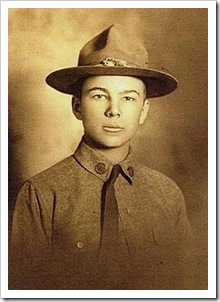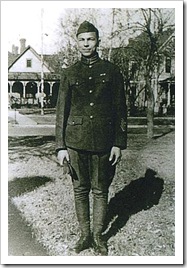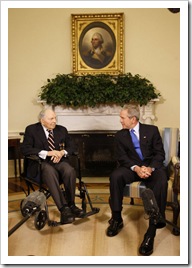Veterans Day, World War One, and Frank Woodruff Buckles [Never Forget]
 Today marks the 90th anniversary of the ending of World War One, which was fought from 1914 to 1918. So what do WWI and Veterans Day have in common. And where does the term "veteran" come from?
Today marks the 90th anniversary of the ending of World War One, which was fought from 1914 to 1918. So what do WWI and Veterans Day have in common. And where does the term "veteran" come from?
Originally, the word veteran meant "a person of long experience" or skill. Derived from the Latin term veteranus, after the American Revolution the word veteran came to be associated specifically with former soldiers of old age who had fought for independence. As time went on, "veteran" was used to describe any former member of the armed forces or a person who had served in the military.
World War I, was known as the "Great War" and was officially concluded on the 11th hour of the 11th Day of November, at 11 A.M. in 1918. On November 11th of the following year, President Woodrow Wilson declared that day as "Armistice Day" in honor of the peace. This day was marked with public celebrations and a two minute halt to businesses at 11 AM. In 1921, the Tomb of the Unknown Soldier was dedicated in Arlington Cemetery with a ceremony on November 11th. After this dedication, Armistice Day was adopted in many states and at the federal level as a day to honor veterans. This was made official in 1938 when an act of Congress made Armistice Day a national holiday.
November 11th of the following year, President Woodrow Wilson declared that day as "Armistice Day" in honor of the peace. This day was marked with public celebrations and a two minute halt to businesses at 11 AM. In 1921, the Tomb of the Unknown Soldier was dedicated in Arlington Cemetery with a ceremony on November 11th. After this dedication, Armistice Day was adopted in many states and at the federal level as a day to honor veterans. This was made official in 1938 when an act of Congress made Armistice Day a national holiday.
In 1954, President Dwight Eisenhower changed the name of Armistice Day to Veterans Day. For several years in the 1970s, Veterans Day was observed in October by many states but in 1978 it was returned to November 11th.
As of today, according to the U.S. Government, there is only one man who fought in World War I that is still alive, according to public record. They are however, wanting to track down anyone who may not be known and still alive. Contact the Department of Veteran Affairs.
Cpl. Frank Woodruff Buckles
 Frank Woodruff Buckles is 107 years old, and currently makes his home in Charles Town, West Virginia. He was born in Bethany, Missouri in 1901 and join the Army when he was 16.
Frank Woodruff Buckles is 107 years old, and currently makes his home in Charles Town, West Virginia. He was born in Bethany, Missouri in 1901 and join the Army when he was 16.
Buckles had first tried to join the Marines. He walked into a Marine Corps recruiting office in Wichita and said he was 18. The recruiter didn't believe him and sent him away. The Navy rejected him as flat-footed. Finally, an Army recruiter in Oklahoma City accepted.
When Buckles was asked by the Army recruiter for his birth certificate, he replied "When I was born in Missouri, they didn't give out birth certificates and the only record we kept was in the family Bible and I am not bringing that down here, so.. they took me."
In December 1917, Buckles was sent to France from Hoboken, N.J. on the RMS Carpathia, the same ship that had rescued the survivors of the Titanic sinking five years before.
During the war, Buckles drove ambulances and motorcycles for the 1st Fort Riley Casual Detachment section of the U.S. Army. After the Armistice in 1918, Buckles escorted prisoners of war back to Germany.
 Following his discharge in 1919, he attended a memorial service in Kansas for those who died in World War I and there he met General Jack "Blackjack" Pershing. The picture to the right was taken on his way to that reception.
Following his discharge in 1919, he attended a memorial service in Kansas for those who died in World War I and there he met General Jack "Blackjack" Pershing. The picture to the right was taken on his way to that reception.
Buckles returned to Germany in 1936 and would stay there until 1938, where he met Adolf Hitler.
Before WWII, in the 1920s, he worked for the White Star Line in Canada.
During WWII, Buckles was a civilian working for an American shipping line or company in the Philippines when the Japanese invaded. He was captured by the Japanese in 1942 and spent three years in a prison camp Los Banos and was rescued on Feb 23, 1945. In 1953, Buckles finally married and bought a 330 acre farm in West Virginia. Unfortunately his wife died in 1999.
Today, Buckles still lives in West Virginia. The U.S. Library of Congress included him in its Veterans Day Project and has audio, video and pictorial information on Buckles' experiences in both world wars, including a full 148-minute interview. His life was featured on the Memorial Day 2007 episode of NBC Nightly News.
 On March 6, 2008, Buckles met with President Bush at the White House. The same day, he attended the opening of a Pentagon exhibit featuring photos of the nine surviving World War I veterans in the world. Of the group, only Buckles and Canadian veteran John Babcock are left. Babcock was unable to attend.
On March 6, 2008, Buckles met with President Bush at the White House. The same day, he attended the opening of a Pentagon exhibit featuring photos of the nine surviving World War I veterans in the world. Of the group, only Buckles and Canadian veteran John Babcock are left. Babcock was unable to attend.
Buckles has said he will be buried at Arlington National Cemetery. He was eligible for cremation and placement in a columbarium at Arlington, but expressed a desire for burial there, which he was not eligible for under current Arlington policy. Friends and family members took up his cause, but made no headway until a family member, Ken Buckles, contacted Ross Perot, whom Frank had met at a history seminar in 2001. Within two weeks, Perot had successfully intervened with the White House, and Buckles received special approval for underground burial at Arlington.
On the subject about the war on terror and the war in Iraq his only comment was:
"I'm no authority, but I'm not in favor of war unless it's an emergency."
Buckles is still around and still quite active. He will be observing this Veterans Day at his farm in West Virginia and can be seen in the news report below.
Two part video about Frank Buckles
PART ONE
PART TWO


0 Responses to "Veterans Day, World War One, and Frank Woodruff Buckles [Never Forget]"
Post a Comment